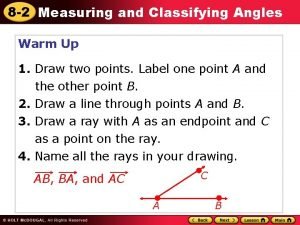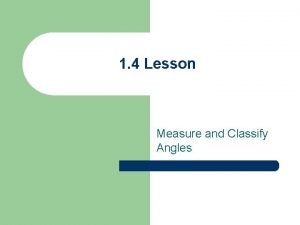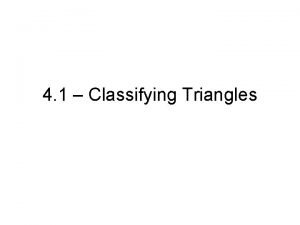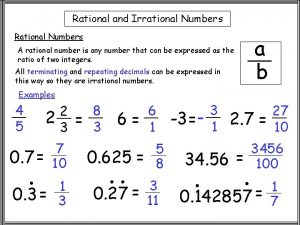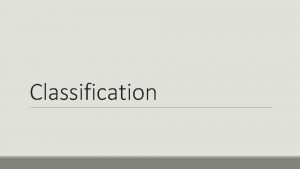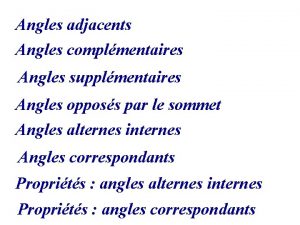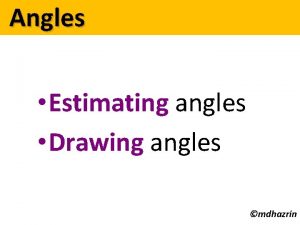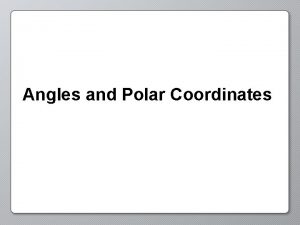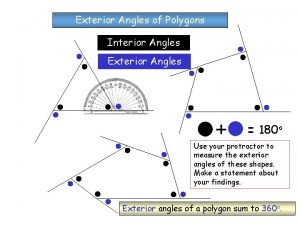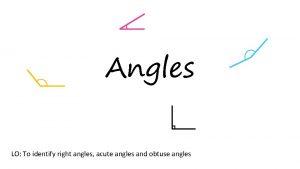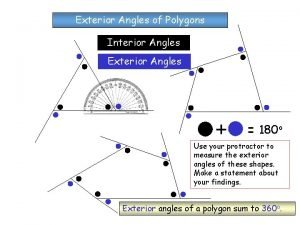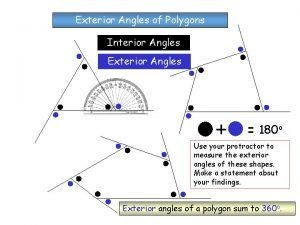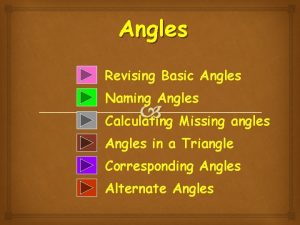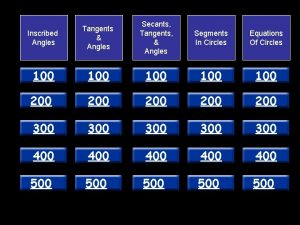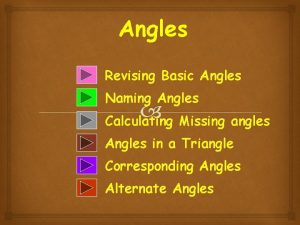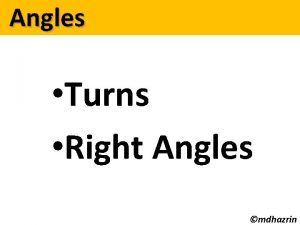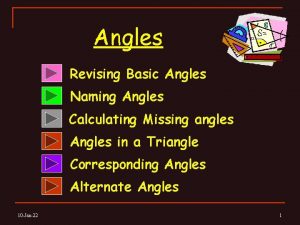8 2 Measuringand and Classifying Angles Warm Up




























- Slides: 28

8 -2 Measuringand and. Classifying. Angles Warm Up Problem of the Day Lesson Presentation Course 11

8 -2 Measuring and Classifying Angles Warm Up 1. Draw two points. Label one point A and the other point B. 2. Draw a line through points A and B. 3. Draw a ray with A as an endpoint and C as a point on the ray. 4. Name all the rays in your drawing. C AB, BA, and AC A Course 1 B

8 -2 Measuring and Classifying Angles Problem of the Day The measure of Jack’s angle is twice that of Amy’s and half that of Nate’s. The sum of the measures of all the angles is equal to 105°. What is the measure of each student’s angle? Jack’s angle: 30°; Nate’s angle: 60°; Amy’s angle: 15° Course 1

8 -2 Measuring and Classifying Angles Learn to name, measure, draw, and classify angles. Course 1

8 -2 Measuring and Classifying Angles Vocabulary angle vertex acute angle right angle obtuse angle straight angle Course 1

8 -2 Measuring and Classifying Angles An angle is formed by two rays with a common endpoint, called the vertex. An angle can be named by its vertex or by its vertex and a point from each ray. The middle point in the name should always be the vertex. Angles are measured in degrees. The number of degrees determines the type of angle. Use the symbol ° to show degrees. Course 1

8 -2 Measuring and Classifying Angles Additional Example 1: Measuring an Angle with a Protractor Use a protractor to measure the angle. F G H • Place the center point of the protractor on the vertex of the angle. Course 1

8 -2 Measuring and Classifying Angles Additional Example 1 Continued Use a protractor to measure the angle. F G H • Place the protractor so that ray GH passes through the 0° mark. Course 1

8 -2 Measuring and Classifying Angles Additional Example 1 Continued Use a protractor to measure the angle. F G H • Using the scale that starts with 0° along ray GH, read the measure where ray GF crosses. Course 1

8 -2 Measuring and Classifying Angles Reading Math m FGH is read “the measure of angle FGH. ” Course 1

8 -2 Measuring and Classifying Angles Additional Example 1 Continued Use a protractor to measure the angle. F G H • The measure of FGH is 120°. Write this as m FGH = 120°. Course 1

8 -2 Measuring and Classifying Angles Check It Out: Example 1 Use a protractor to measure the angle. G H I • Place the center point of the protractor on the vertex of the angle. Course 1

8 -2 Measuring and Classifying Angles Check It Out: Example 1 Continued Use a protractor to measure the angle. G H I • Place the protractor so that ray HI passes through the 0° mark. Course 1

8 -2 Measuring and Classifying Angles Check It Out: Example 1 Continued Use a protractor to measure the angle. G H I • Using the scale that starts with 0° along ray HI, read the measure where ray HG crosses. Course 1

8 -2 Measuring and Classifying Angles Check It Out: Example 1 Continued Use a protractor to measure the angle. G H • The measure of m GHI = 70°. Course 1 I GHI is 70°. Write this as

8 -2 Measuring and Classifying Angles Additional Example 2: Drawing an Angle with a Protractor Use a protractor to draw an angle that measures 80°. • Draw a ray on a sheet of paper. Course 1

8 -2 Measuring and Classifying Angles Additional Example 2 Continued Use a protractor to draw an angle that measures 80°. • Place the center point of the protractor on the endpoint of the ray. • Place the protractor so that the ray passes through the 0° mark. Course 1

8 -2 Measuring and Classifying Angles Additional Example 2 Continued Use a protractor to draw an angle that measures 80°. • Make a mark at 80° above the scale on the protractor. • Use a straightedge to draw a ray from the endpoint of the first ray through the mark you made at 80°. Course 1

8 -2 Measuring and Classifying Angles Check It Out: Example 2 Use a protractor to draw an angle that measures 45°. • Draw a ray on a sheet of paper. Course 1

8 -2 Measuring and Classifying Angles Check It Out: Example 2 Continued Use a protractor to draw an angle that measures 45°. • Place the center point of the protractor on the endpoint of the ray. • Place the protractor so that the ray passes through the 0° mark. Course 1

8 -2 Measuring and Classifying Angles Check It Out: Example 2 Continued Use a protractor to draw an angle that measures 45°. • Make a mark at 45° above the scale on the protractor. • Use a straightedge to draw a ray from the endpoint of the first ray through the mark you made at 45°. Course 1

8 -2 Measuring and Classifying Angles An acute angle measures less than 90°. A right angle measures exactly 90°. Reading Math Right angles are usually marked with a Course 1 symbol.

8 -2 Measuring and Classifying Angles An obtuse angle measures more than 90° and less than 180°. A straight angle measures exactly 180°. Course 1

8 -2 Measuring and Classifying Angles Additional Example 3: Classifying Angles Classify each angle as acute, right, obtuse, or straight. A. The angle measures less than 90°, so it is an acute angle. Course 1 B. The angle measures exactly 90°, so it is a right angle.

8 -2 Measuring and Classifying Angles Check It Out: Example 3 Classify each angle as acute, right, obtuse, or straight. A. The angle measures less than 90°, so it is an acute angle. Course 1 B. The angle measures exactly 180°, so it is a straight angle.

8 -2 Measuring and Classifying Angles Additional Example 4: Application A welder used this piece of metal on his project. Classify X, Y, and Z. Y X Z W X right The angle is marked as a right angle. Y obtuse The angle measures more than 90° and less than 180°. Z acute The angle measures less than 90°. Course 1

8 -2 Measuring and Classifying Angles Check It Out: Example 4 A metal jeweler used this piece of metal on her project. Classify A, B, and D. A D B C A obtuse B acute The angle measures more than 90° and less than 180°. The angle measures less than 90°. D The angle is marked as a right angle. Course 1 right

8 -2 Measuring and Classifying Angles Lesson Quiz Use a protractor to draw an angle with the given measure. Tell what type of angle it is. 1. 140° Check student drawings; obtuse 2. 20° Check student drawings: acute 3. Draw a right angle. 4. Is the angle shown closer to 30° or 120°? 30° Course 1
 Vertical angles
Vertical angles Measuring and classifying angles
Measuring and classifying angles Measure and classify angles
Measure and classify angles Classifying triangles
Classifying triangles Angles & lines unit warm ups
Angles & lines unit warm ups 3 parallel lines and transversals
3 parallel lines and transversals Module 15 lesson 1 central angles and inscribed angles
Module 15 lesson 1 central angles and inscribed angles G v black classification
G v black classification Supplementary angles are adjacent angles
Supplementary angles are adjacent angles Answers
Answers Characteristic of a triangle
Characteristic of a triangle Genus order family
Genus order family Whats a rational number.
Whats a rational number. Classifying degrees of polynomials
Classifying degrees of polynomials Integers rational numbers and whole numbers
Integers rational numbers and whole numbers Classifying triangles 4-1
Classifying triangles 4-1 Scientific skills in science
Scientific skills in science Lesson 2 classifying organisms answer key
Lesson 2 classifying organisms answer key Types of matter elements compounds and mixtures
Types of matter elements compounds and mixtures Chapter 20 patient collections and financial management
Chapter 20 patient collections and financial management Comparing and classifying
Comparing and classifying Classifying and exploring life lesson 2 answers
Classifying and exploring life lesson 2 answers Classifying and exploring life
Classifying and exploring life Fungi cell
Fungi cell Discipline of classifying and naming organisms
Discipline of classifying and naming organisms The science of naming and classifying organisms
The science of naming and classifying organisms Exploring and classifying life
Exploring and classifying life Discipline of classifying and naming organisms
Discipline of classifying and naming organisms What is the hierarchical system used to classify organisms?
What is the hierarchical system used to classify organisms?

